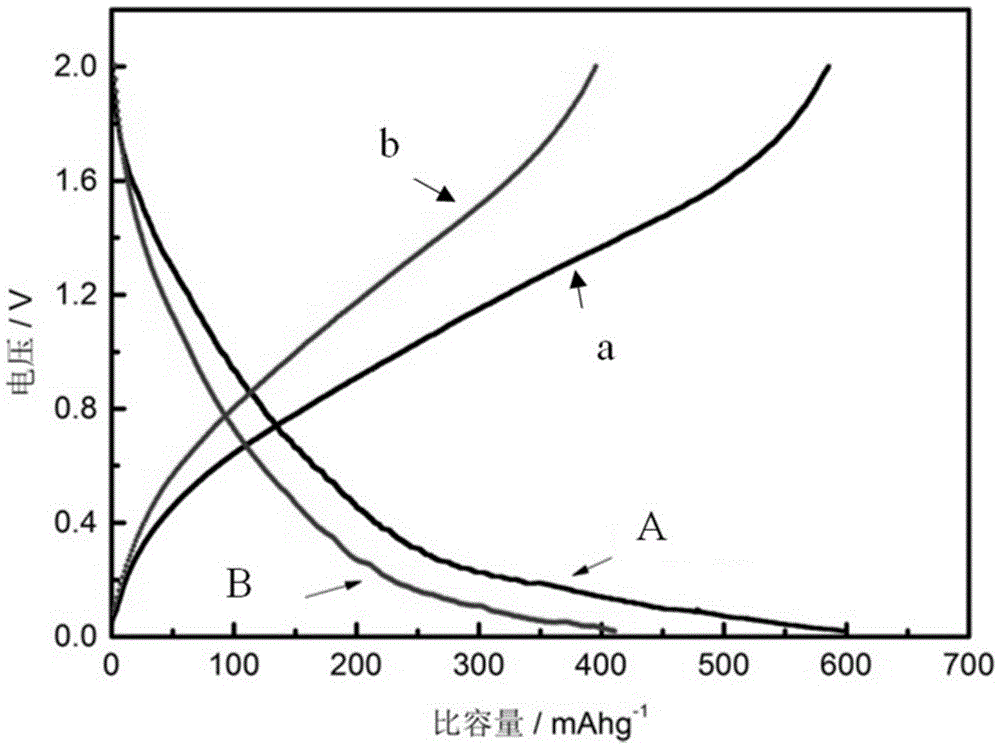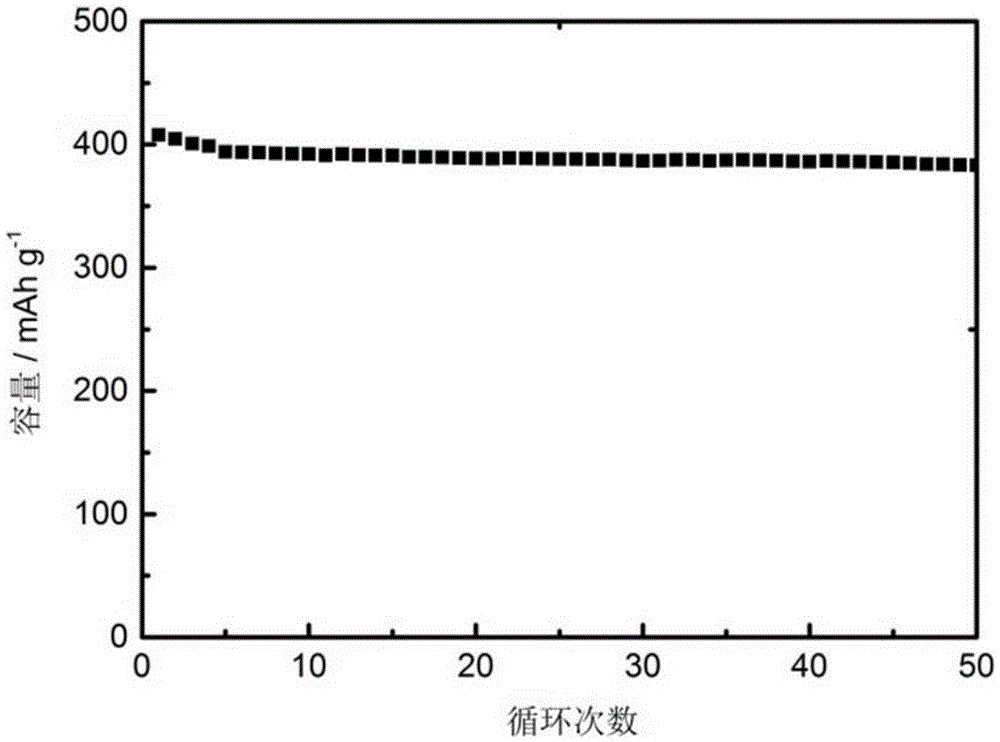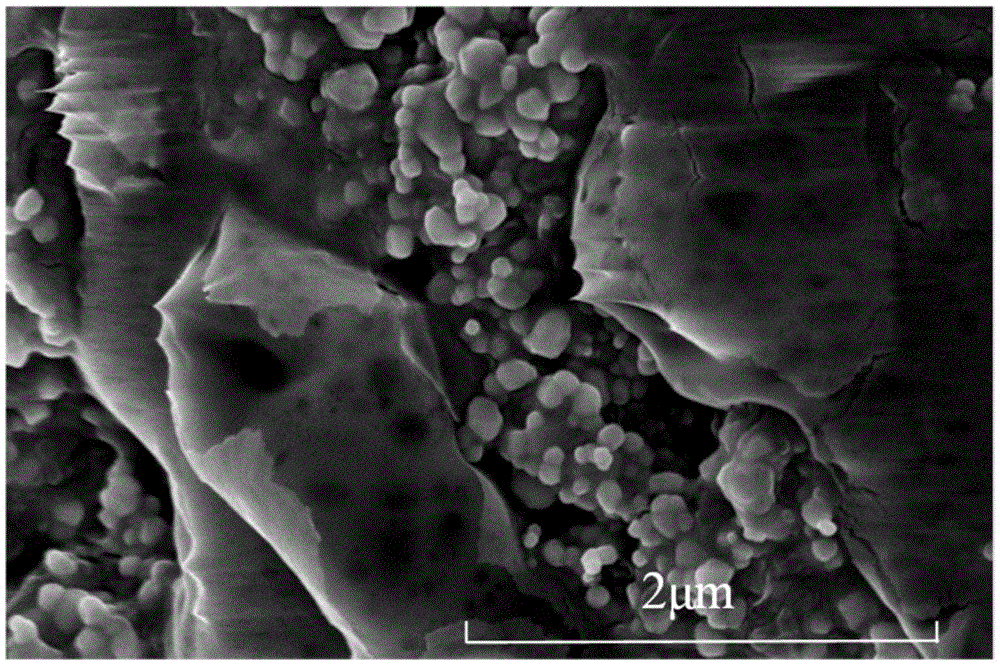Negative material for sodium-ion battery and preparation method for negative material and sodium-ion battery
A technology for sodium ion batteries and negative electrode materials, applied in battery electrodes, secondary batteries, circuits, etc., can solve the problems of cycle performance decay, battery capacity decay, and obvious volume expansion and shrinkage effects, so as to improve electrochemical performance and suppress volume. Effect, simple effect of preparation method
- Summary
- Abstract
- Description
- Claims
- Application Information
AI Technical Summary
Problems solved by technology
Method used
Image
Examples
Embodiment 1
[0036] Preparation method of sodium ion battery negative electrode material:
[0037] (1) Weigh tin tetrachloride and copper sulfate in turn, so that the molar ratio of tin and copper is 0.4:0.6; weigh titanium dioxide with a particle size of 180-220nm, so that the number of moles of titanium is equal to the ratio of moles of tin and copper. And; Take monolayer graphene, make graphene quality be 8% of the total mass of tin element and copper element;
[0038]Using deionized water as a dispersant, tin tetrachloride and copper sulfate are formulated to make the total concentration of tin and copper elements 1mol / L, and titanium dioxide and graphene are added to disperse evenly to obtain a mixed solution; sodium hydroxide is formulated to a concentration of 5mol / L precipitant;
[0039] (2) Add the precipitating agent into the reaction kettle containing the mixed solution at a uniform speed. After the mixed reaction, let it stand for 12 hours, filter, wash with deionized water tw...
Embodiment 2
[0043] Preparation method of sodium ion battery negative electrode material:
[0044] (1) Weigh tin protochloride and copper sulfate successively, make the molar ratio of tin element and copper element be 0.1:0.9; Take the titanium dioxide with particle diameter about 200nm, make the molar number of titanium element be equal to the sum of tin-copper molar number; Weighing 5-10 layers of graphene, so that the graphene mass is 2% of the total mass of tin and copper elements;
[0045] Using deionized water as a dispersant, tin protochloride and copper sulfate are formulated so that the total concentration of tin and copper elements is 2mol / L, and titanium dioxide and graphene are added to disperse evenly to obtain a mixed solution; sodium hydroxide is formulated to a concentration of 1mol / L precipitant;
[0046] (2) Add the precipitating agent into the reaction kettle containing the mixed liquid at a uniform speed, and after the mixed reaction, age and stand for 11 hours, filter...
Embodiment 3
[0050] Preparation method of sodium ion battery negative electrode material:
[0051] (1) Weigh stannous chloride and cupric chloride in turn, so that the molar ratio of tin and copper is 0.3:0.7, and weigh titanium dioxide with a particle size of about 200nm, so that the molar number of titanium is equal to the sum of the molar numbers of tin and copper ; Weighing 5-10 layers of graphene, so that the quality of graphene is 10% of the total mass of tin element and copper element;
[0052] Using deionized water as a dispersant, tin protochloride and cupric chloride are formulated so that the total concentration of tin and copper elements is 2mol / L, and titanium dioxide and graphene are added to disperse evenly to obtain a mixed solution; sodium hydroxide is prepared into a precipitating agent with a concentration of 3mol / L;
[0053] (2) Add the precipitating agent into the reaction kettle containing the mixed liquid at a uniform speed, and after the mixed reaction, age and sta...
PUM
| Property | Measurement | Unit |
|---|---|---|
| particle diameter | aaaaa | aaaaa |
| particle diameter | aaaaa | aaaaa |
Abstract
Description
Claims
Application Information
 Login to View More
Login to View More - R&D
- Intellectual Property
- Life Sciences
- Materials
- Tech Scout
- Unparalleled Data Quality
- Higher Quality Content
- 60% Fewer Hallucinations
Browse by: Latest US Patents, China's latest patents, Technical Efficacy Thesaurus, Application Domain, Technology Topic, Popular Technical Reports.
© 2025 PatSnap. All rights reserved.Legal|Privacy policy|Modern Slavery Act Transparency Statement|Sitemap|About US| Contact US: help@patsnap.com



